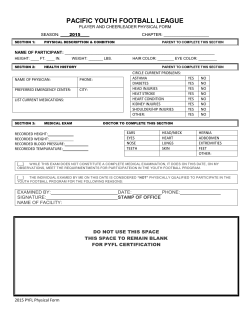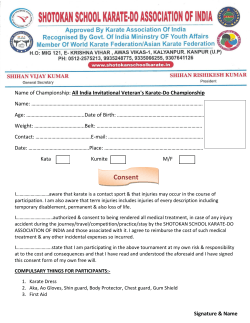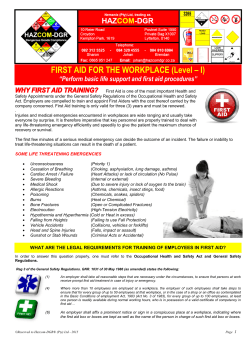
Dias nummer 1 - loebeskadekonference2015.org
Department of Neuroscience and Pharmacology Running technique and injuries Peter C. Raffalt PhD student, MSc. Department of Neuroscience and Pharmacology Neural Control of Movement Laboratory University of Copenhagen Department of Neuroscience and Pharmacology Content Part 1 • What is running technique? • Why do we want to alter running technique? • How do we alter running technique? • Running technique and injuries Part 2 • An alternative theoretical approach to running technique and injuries Department of Neuroscience and Pharmacology What is running technique? • • • When a skill is put into a sport it becomes a technique that can be qualitatively evaluated The technique should be optimized to improve performance The possibilities and limitations of our body determines the potential technique utilized • Running technique aims: • At producing the highest possible speed • At producing the most economical speed • Running technique is described by a number of different key points related to the movements of the body parts during the running stride • Qualitative and quantitative description Bosch and Klomp 2001 Department of Neuroscience and Pharmacology Why do we want to alter running technique? - and how do we do it? • Improve performance! • Run faster • Run more economically • Run safer? • • • • Structured technical training over long periods of time Training of key elements in the movements during running Training of lower body strength and joint flexibility Biomechanical and anatomical arguments for the selected key points Bosch and Klomp 2001 Department of Neuroscience and Pharmacology Running technique alterations – from practice to theory and back Top To runners New theories To Old theories To Analysis and Todescription KeyTo points Implementation To Department of Neuroscience and Pharmacology Running technique and injuries • A number of isolated biomechanical parameters have been related to lower extremity running injuries e.g. • Rear foot angle (excessive rear foot motion) (James et al. 1978; Tiberio 1987) • Ground reaction force (Hreljac et al. 2000; Messier and Pittala 1998) • Loading rate during the initial impact (Milner et al. 2006; Pohl et al. 2008) • Knee adduction moment (Stefanyshyn et al. 2006) • These types of studies provide biomechanical evidence for differences in movements between injured and injury-free runners but do not lead to a clear understanding of the injury mechanisms. Department of Neuroscience and Pharmacology Running technique and injuries • New theories about the “perfect/naturally” way of running have led to local or global alterations of the running technique • • • • • Barefoot running Minimalistic running shoes Forefoot running Namba Aruki – Japanese style of walking and running Pose running Department of Neuroscience and Pharmacology Running technique and injuries • • • • A global well defined alteration of the technique Control group Registration of injuries Exclude other sources potentially leading to injuries • One well defined alternative technique has been suggested: • Pose running (by Nicholas Romanov) • “Efficient, injury-free running taught through poses. Use the Pose Method® of Running technique to prevent injuries and to dramatically improve your running performance.” (www.posetech.com) • The biomechanical theory behind this running technique has been strongly criticized. Romanov and Fletcher 2007; Brodie et al. 2008 Department of Neuroscience and Pharmacology Running technique and injuries • Two studies on Pose running have investigated running economy and joint moments (indirect measure of joint loading) • Same authors (incl. Nicholas Romanov) of both studies • Showed increased cost of running with Pose running technique (Dallam et al. 2005) • Showed lower eccentric work of the knee joint and increased eccentric work of the ankle joint (Arendse et al. 2004) • Conclusion: decreased performance and redistributed joint load (potentially changed injury location) Department of Neuroscience and Pharmacology Running technique and injuries Summery part 1 • The traditional approach has provided limited consensus on the causality between running technique and injuries. • Intuitively, any kind of running styles could potentially lead to injuries. • But no global alteration has been shown to reduce the risk of injuries. Department of Neuroscience and Pharmacology An alternative theoretical approach to running technique and injuries • The human body as a complex system consisting of many interacting parts • The motor control as mastering the redundant system of multiple functional degrees of freedom through coordination of segments (Bernstein 1967; Turvey 1990) • Movement variability is induced in varies levels of the system (e.g. motor output, muscle force, force transmission, range of motion) (Newell and Corcos 1993) • The movement variability has two characteristics of interest: • The amount • The temporal structure (Stergiou (ed) 2004) Department of Neuroscience and Pharmacology An alternative theoretical approach to running technique and injuries • The amount of movement variability was significant lower in runners with patellofemoral pain for coordination of thigh and shank coordination (Hamill et al. 1999; Heiderscheit et al. 2002) • Same pattern has been shown for runners with lower back pain (Seay et al. 2011) Hamill et al. 2012; Hamill et al. 1999 • And for runners with a history of iliotibial band syndrome (Miller et al. 2008) • However, too much variability could be suggested as being equally “bad” (Hamill et al. 2012) Department of Neuroscience and Pharmacology An alternative theoretical approach to running technique and injuries Figure 1 Loss of complexity hypothesis based on the work of Lipsitz and colleagues (2002) applied to injury or pathology. Top and middle panels: over time reductions in effective degrees of freedom, interacting components and synergies become associated with a loss of variability in the system. When these reductions in degrees of freedom and variability reach a critical threshold, injury or disease may emerge (bottom panel). Hamill et al. 2012 Hamill et al. 2012 Department of Neuroscience and Pharmacology An alternative theoretical approach to running technique and injuries • Movement variability across time has a structure depending on the functionality of the system (Stergiou 2004) Department of Neuroscience and Pharmacology An alternative theoretical approach to running technique and injuries • Reduced or increased in number of functional degrees of freedom will potentially change both the amount and the temporal structure of movement variability • To much or to little variability can potentially increase the risk of running injuries • Changed temporal structure towards either random or periodic patterns can potentially decrease the adaptability against external perturbations and increase the risk of injuries • The number of functional degrees of freedom and coordination determines both the amount and temporal structure of the movement variability Department of Neuroscience and Pharmacology Conclusion • An alternative approach to the mechanisms underlying running injuries suggests a healthy stage of sufficient movement variability with a chaotic structure is linked to a lower risk of running injuries • It could be speculated that training of running coordination skills and variations in running speed, running surface and training load will ensure this optimal movement variability • In addition, specific training to prevent strength deficits, strength imbalance and improper flexibility could ensure a sufficient number of functional degrees of freedom. Department of Neuroscience and Pharmacology Thank you Questions?
© Copyright 2025









